The ASUS Zenbook UX305 Review
by Brett Howse on March 25, 2015 8:00 AM ESTDisplay
The UX305 comes with two display options. The base model is a 13.3 inch 1920x1080 IPS display, and no touch available. The display has a matte finish to it, which helps with glare. ASUS will also be offering a 3200x1800 Plane-to-Line Switching (PLS) model with a matte finish, and that model should be available in April or so. Optionally, both models can be equipped with touch.
The model that we received is the 1920x1080 version, and the display is from AU Optronics and is model AUO212D. At 166 pixels per inch, it is a good resolution for this size of display. It is a full RGB stripe, which is pretty typical for this resolution and size panel.
The anti-glare coating causes the sub-pixel distortion seen on this image. The AU display is a 6-bit model, but that is unsurprising given the low cost of this device. As an IPS display, it has great viewing angles and is a big step up over the TN panels that you may still find at this level of cost.
To test the display accuracy and its ability to reproduce color, we use SpectralCal’s CalMAN 5 software suite, with an X-Rite i1Display Pro colorimeter for brightness and contrast readings, and the X-Rite i1Pro spectrophotometer for color accuracy.
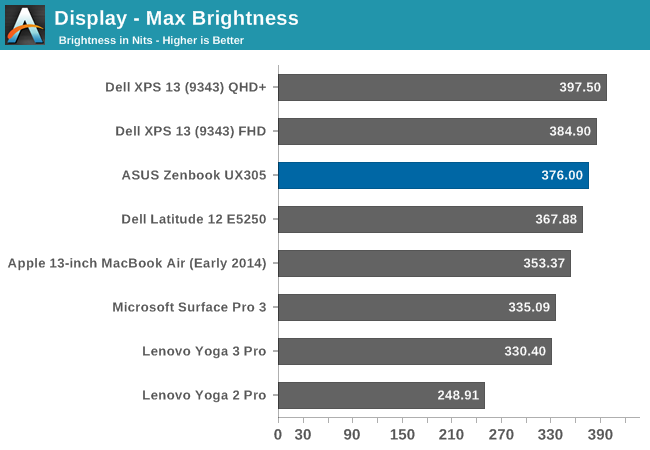
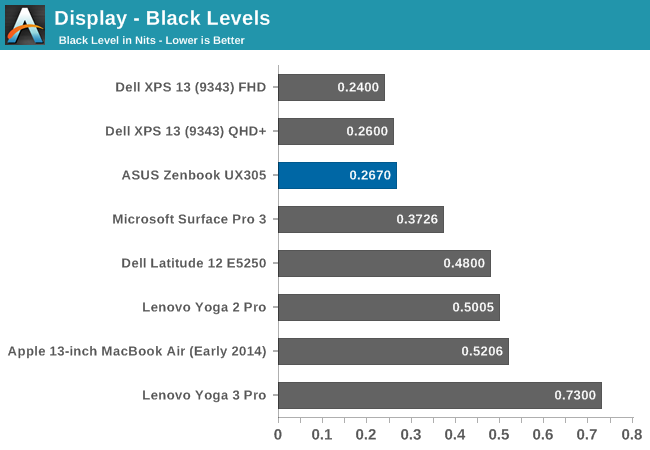
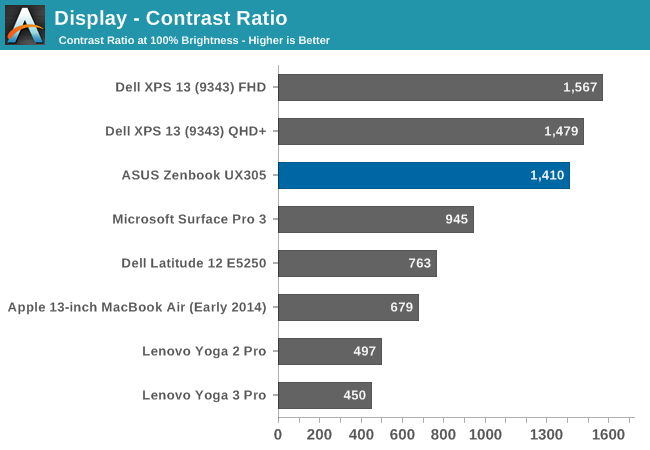
The maximum brightness for the UX305 is an impressive 376 nits. This combined with the anti-glare coating should make this a great laptop for any sort of bright room, or even outside. Even better, the panel has excellent black levels. ASUS rates the display for a contrast ratio of 500:1, but the model we received blew past that for a 1410:1 ratio which is fantastic.
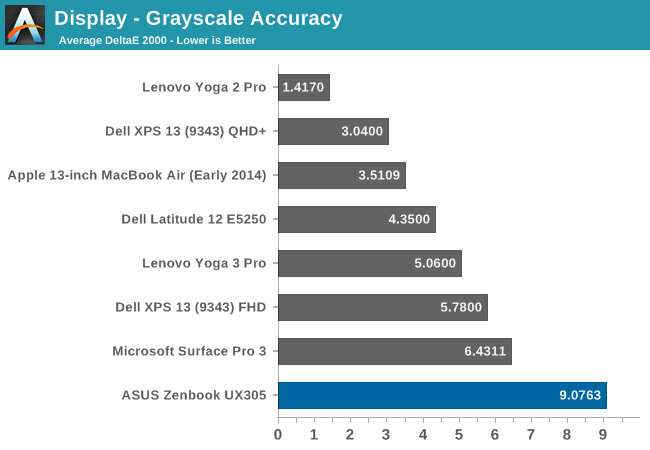
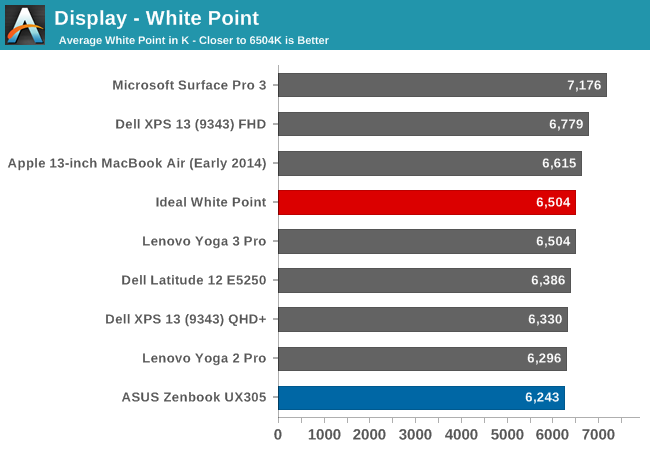
Unfortunately the great brightness and contrast is about where this display ends. The grayscale average is actually flattering the ASUS with a score of just over 9, because the error rate is between 12 and 13 from 70% brightness on. These are huge errors, since anything over 5 is a poor result, and really we are aiming for scores under three. The white point is off, and there is a huge green shift in the display by default.
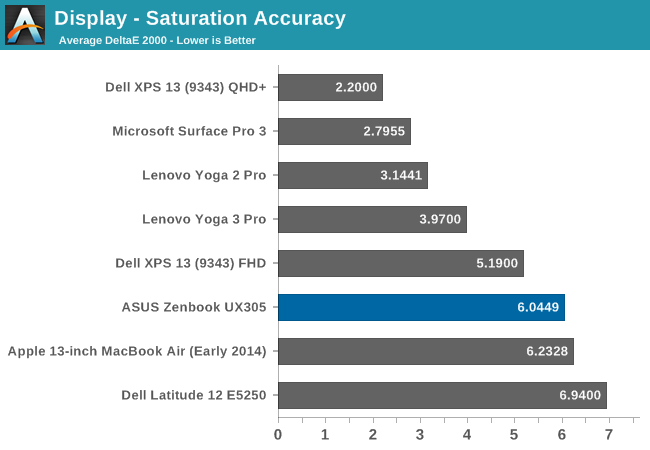
The saturation sweeps are not quite as bad as the grayscale, with the UX305 coming in just over 6. It is oversaturated on blue, undersaturated on red, and there is a green shift which pulls the yellows and teals off of their axis.
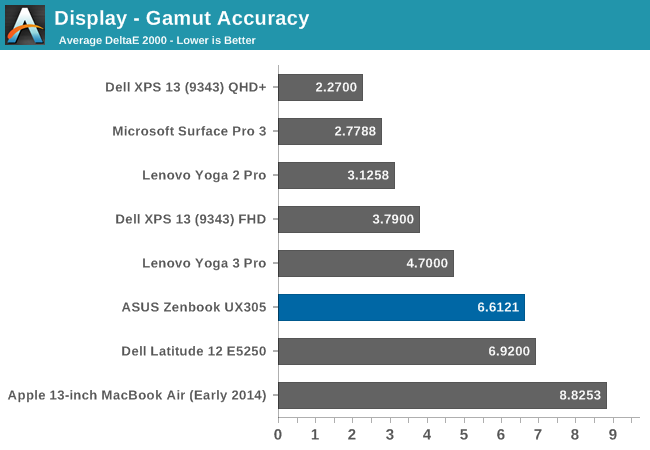
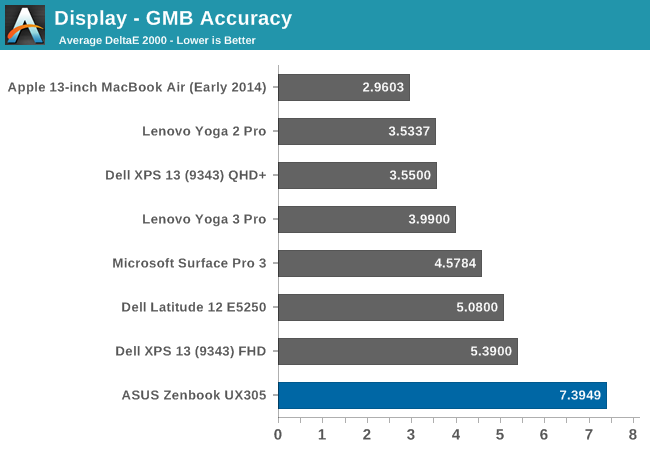
The GMB test is a more comprehensive test, and it scores very poorly again with a score over seven. The worst offenders were of course the white levels, which are very off, and the flesh tones on this display all had errors way over many of the other colors.
This is a very poor result and throws us back several years in terms of calibration. As far as out of the box performance goes the display can hit the entire sRGB colorspace, and as an IPS display it has great viewing angles, but otherwise there is nothing good to be said about this display as far as out of the box color accuracy goes.
To see if the display can be improved on with aftermarket calibration, I have run the display through our calibration software to try to fix some of the errors we encountered. Generally icc profiles will only really have a major effect on the grayscale, but that is the worst part of this display so hopefully we will be able to fix some of these issues.
Once calibrated, the display is almost completely different. There is still a large error on 100% white, but the overall grayscale drops to 0.9582, with a bit too much green but it is barely noticeable on most levels. The gamut drops to just 3.1256, saturation plummets to 1.9571, and the GMB test comes in at 2.3099.
If ASUS would take the time to include an icc profile for this display from the factory, it would be a lot better. It is amazing to me that ASUS would ship this display with it so far out of calibration, especially when calibrated it is almost perfect. Yes, the $699 price point is a factor, but the hard work was already done in getting a display that can produce these numbers. The easy part is taking the time to make it do that.


















164 Comments
View All Comments
darkich - Friday, March 27, 2015 - link
..as for "thoroughly trashing" in CPU(or should i say, in software-dependent web benchmarks only), well just wait for the 14nm Cyclone and Cortex A72.By year's end we will see ARM CPU beating core m even on 2.5w TDP and $50 worth of chips
Morawka - Thursday, March 26, 2015 - link
See this is how you treat your customers.This Asus Laptop does not have a Ethernet Port since it's so thin, but GOOD guy asus includes a ethernet adapter in the box.
THen you turn around and look at apple's offering. 1 port, Twice as expensive, and requires you to buy a $80 adapter right after shelling out $1300 + Tax.
With the Asus laptop, you can avoid sales tax easily.
with the apple laptop, you can't.. They got sales tax everywhere because of apple stores in every state. Your only hope is mac mall and they lag behind several months on new models.
DavidTJ - Thursday, March 26, 2015 - link
Exactly what model is reviewed?I have looked at UX305FA-FB003P and it's totally different. Also UX305FA-FC008H looks different (4GB only)...
Shadowmaster625 - Thursday, March 26, 2015 - link
Can you add a DOTA 2 battery life test? Also, why does the XPS 13 do sooooo much better in the normalized battery life test?kyuu - Thursday, March 26, 2015 - link
It doesn't do *that* much better (well, I guess it does when you consider the XPS 13 uses a higher wattage CPU). But Dell worked closely with Intel and Microsoft to squeeze every little bit of power savings they could out of the hardware/software package, so I imagine that's responsible for the difference.heytimbo - Thursday, March 26, 2015 - link
I tried one of the first gen UX31. If I recall, it was a 128GB SSD and so full of bloatware about 30 GB were free. I took it back to the retailer and questioned. I was told to buy a standalone copy of windows and install. It seemed easier to return the PC and go Mac. I have not looked back. ASUS, you make great products but are you still filling the laptops with bloatware?Dorek - Thursday, March 26, 2015 - link
"If I recall, it was a 128GB SSD and so full of bloatware about 30 GB were free."I don't believe you. The OS takes about 10-20 GB, so that's roughly 100GB left. You're saying 70 GIGABYTES were taken up by crapware? That's bullshit. That'd be like, 20 installs of Adobe Premiere Pro, or two installs of a high-end AAA 2014 game. You're lying.
heytimbo - Friday, March 27, 2015 - link
No, and that is why I returned the PC. I could not believe the level of bloatware. I am curious about these current machines. If I see any at a local store I may test to see.beehofer - Thursday, March 26, 2015 - link
No back-lit Keyboard was the deal-breaker for me. I would have been very interested but I work/play in dark settings often and cannot go back to a non back-lit keyboard. It was a gross mistake by Asus. Get with it man!creed3020 - Thursday, March 26, 2015 - link
I don't know where that $699 price is coming from. Amazon US is showing around $899 and in Canada the cost is $1200. So this "budget" ultrabook just went through the roof in pricing.I'm thoroughly impressed by it but this is MacBook pricing...